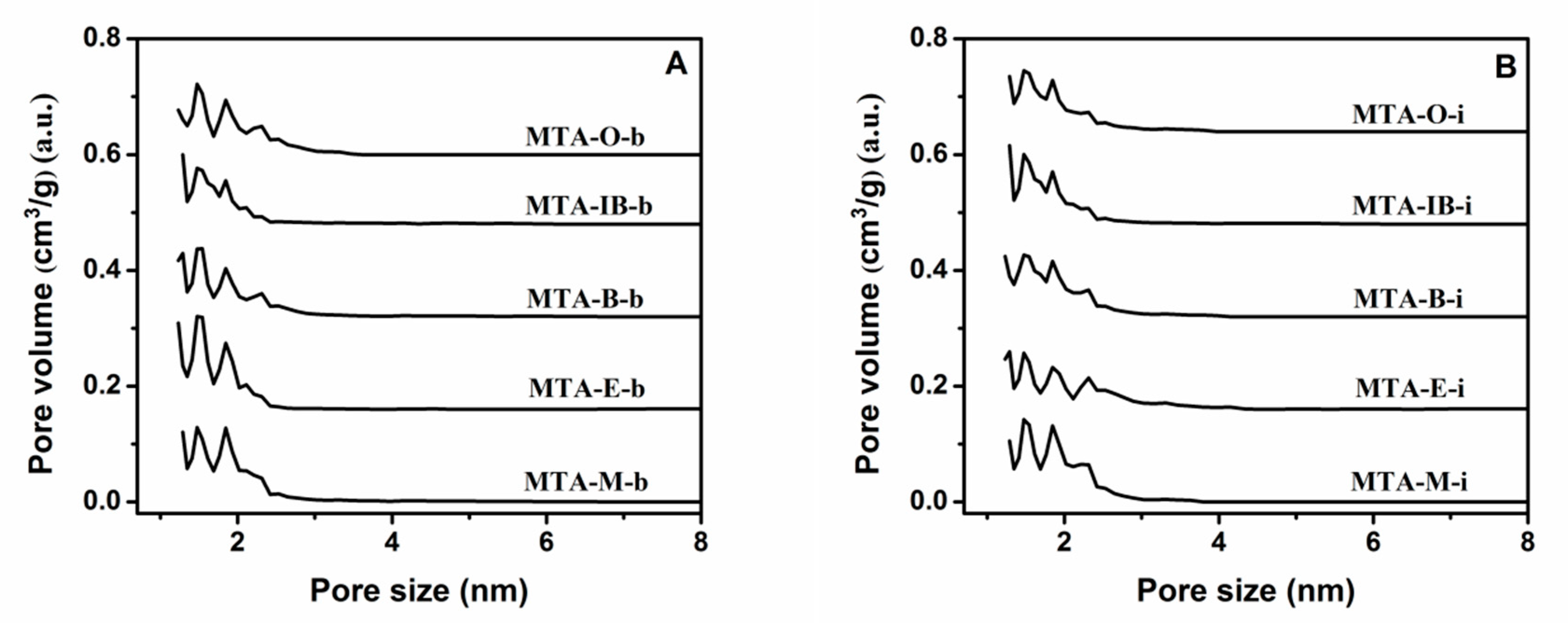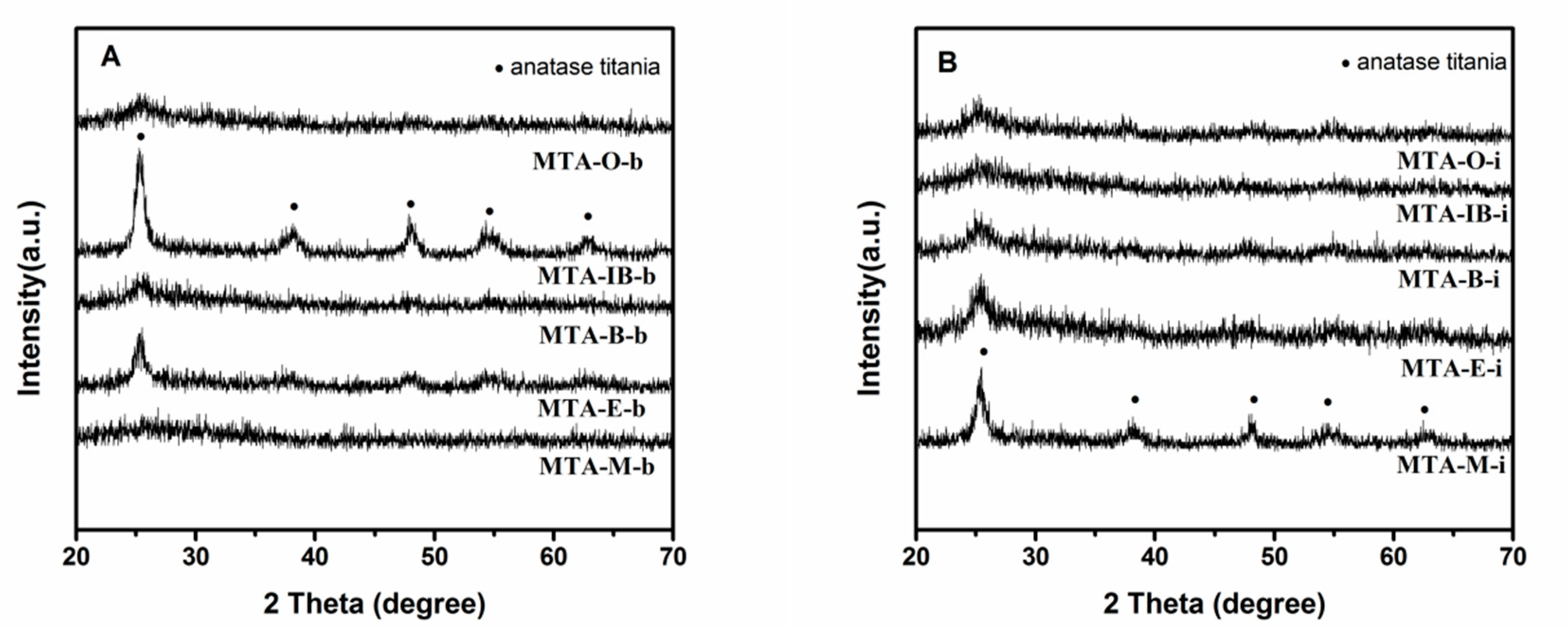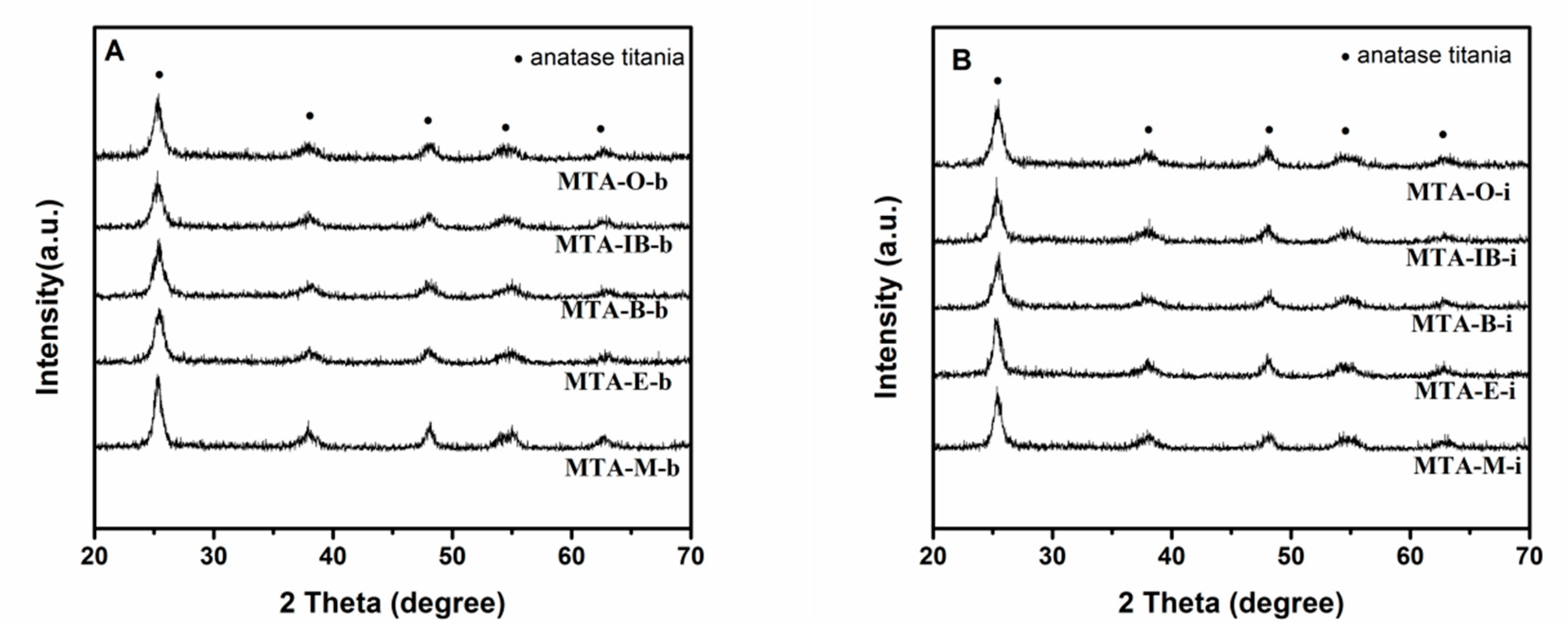Facile Synthesis of Super-Microporous Titania–Alumina with Tailored Framework Properties
Abstract
:1. Introduction
2. Materials and Methods
2.1. Chemicals
2.2. Preparation of Super-Microporous Titania–Alumina Materials
2.3. Characterization
3. Results and Discussions
4. Conclusions
Author Contributions
Funding
Acknowledgments
Conflicts of Interest
References
- Li, W.; Zhao, D. An overview of the synthesis of ordered mesoporous materials. Chem. Commun. 2013, 49, 943–946. [Google Scholar] [CrossRef] [PubMed]
- Wang, L.; Wang, X.; Cheng, J.; Ning, P.; Lin, Y. Coupling catalytic hydrolysis and oxidation on Mn/TiO2-Al2O3 for HCN removal. Appl. Surf. Sci. 2018, 439, 213–221. [Google Scholar] [CrossRef]
- Vo, T.K.; Kim, W.S.; Kim, S.S.; Yoo, K.S.; Kim, J. Facile synthesis of Mo/Al2O3-TiO2 catalysts using spray pyrolysis and their catalytic activity for hydrodeoxygenation. Energy Convers. Manag. 2018, 158, 92–102. [Google Scholar] [CrossRef]
- Matsuda, A.; Kikuchi, T.; Murayama, R.; Kogure, T.; Katagiri, K.; Muto, H.; Sakai, M. Formation of photocatalytic novel oxide crystallites with Al:Ti = 1:1 in Al2O3-TiO2 gels by mechanochemical treatment. J. Nanosci. Nanotechnol. 2009, 9, 342–349. [Google Scholar] [CrossRef] [PubMed]
- Duan, A.; Li, R.; Jiang, G.; Gao, J.; Zhao, Z.; Wan, G.; Zhang, D.; Huang, W.; Chung, K.H. Hydrodesulphurization performance of NiW/TiO2-Al2O3 catalyst for ultra clean diesel. Catal. Today 2009, 140, 187–191. [Google Scholar] [CrossRef]
- Yılmaz, R.; Kurt, A.O.; Demir, A.; Tatlı, Z. Effects of TiO2 on the mechanical properties of the Al2O3-TiO2 plasma sprayed coating. J. Eur. Cream. Soc. 2007, 27, 1319–1323. [Google Scholar] [CrossRef]
- Ohishi, Y.; Miyauchi, Y.; Ohsato, H.; Kakimoto, K. Controlled temperature coefficient of resonant frequency of Al2O3-TiO2 ceramics by annealing treatment. Jpn. J. Appl. Phys. 2004, 43, L749. [Google Scholar] [CrossRef]
- Mohammadi, M.R. Semiconductor TiO2-Al2O3 thin film gas sensors derived from aqueous particulate sol-gel process. Mater. Sci. Semicond. Proc. 2014, 27, 711–718. [Google Scholar] [CrossRef]
- Kim, J.Y.; Kang, S.H.; Kim, H.S.; Sung, Y.E. Preparation of highly ordered mesoporous Al2O3/TiO2 and its application in dye-sensitized solar cells. Langmuir 2009, 26, 2864–2870. [Google Scholar] [CrossRef]
- Wang, W.C.; Tsai, M.C.; Yang, J.; Hsu, C.; Chen, M.J. Efficiency enhancement of nanotextured black silicon solar cells using Al2O3/TiO2 dual-layer passivation stack prepared by atomic layer deposition. ACS Appl. Mater. Interface 2015, 7, 10228–10237. [Google Scholar] [CrossRef]
- Kim, Y.S.; Yun, S.J. Nanolaminated Al2O3–TiO2 thin films grown by atomic layer deposition. J. Cryst. Growth 2005, 274, 585–593. [Google Scholar] [CrossRef]
- Wagner, G.W.; Procell, L.R.; Munavalli, S. 27Al, 47, 49Ti, 31P, and 13C MAS NMR study of VX, GD, and HD reactions with nanosize Al2O3, conventional Al2O3 and TiO2, and aluminum and titanium metal. J. Phys. Chem. C 2007, 111, 17564–17569. [Google Scholar] [CrossRef]
- Mas-Guindal, M.J.; Benko, E.; Rodriguez, M.A. Nanostructured metastable cermets of Ti–Al2O3 through activated SHS reaction. J. Alloy Compd. 2008, 454, 352–358. [Google Scholar] [CrossRef]
- Kim, S.E.; Lim, J.H.; Lee, S.C.; Nam, S.C.; Kang, H.G.; Choi, J. Anodically nanostructured titanium oxides for implant applications. Electrochim. Acta 2008, 53, 4846–4851. [Google Scholar] [CrossRef]
- Wu, H.C.; Ku, Y. Enhanced performance of chemical looping combustion of methane with Fe2O3/Al2O3/TiO2 oxygen carrier. RSC Adv. 2018, 8, 39902–39912. [Google Scholar] [CrossRef] [Green Version]
- Morris, S.M.; Horton, J.A.; Jaroniec, M. Soft-templating synthesis and properties of mesoporous alumina-titania. Microporous Mesoporous Mater. 2010, 128, 180–186. [Google Scholar] [CrossRef]
- Liu, E.; Vezzoli, M.; Locke, A.J.; Frost, R.L.; Martens, W.N. Fabrication of macro-mesoporous titania/alumina core-shell materials in oil/water interface. J. Colloid Interface Sci. 2014, 436, 194–203. [Google Scholar] [CrossRef]
- Guo, C.; Shen, Z.; Hu, Q.; Wang, S.; Ling, F. The solvothermal synthesis, structure and properties of Al2O3·TiO2 mesoporous material. Mater. Chem. Phys. 2015, 151, 288–294. [Google Scholar]
- Shpeizer, B.G.; Clearfield, A.; Heising, J.M. New families of supermicroporous metal oxides: The link between zeolites and mesoporous materials. Chem. Commun. 2005, 18, 2396–2398. [Google Scholar] [CrossRef]
- Song, K.; Guan, J.; Wang, Z.; Xu, C.; Kan, Q. Post-treatment of mesoporous material with high temperature for synthesis super-microporous materials with enhanced hydrothermal stability. Appl. Surface Sci. 2009, 255, 5843–5846. [Google Scholar] [CrossRef]
- Gu, F.N.; Wei, F.; Yang, J.Y.; Lin, N.; Lin, W.G.; Wang, Y.; Zhu, J.H. New strategy to synthesis of hierarchical mesoporous zeolites. Chem. Mater. 2010, 22, 2442–2450. [Google Scholar] [CrossRef]
- Kim, J.C.; Ryoo, R.; Opanasenko, M.V.; Shamzhy, M.V.; Cejka, J. Mesoporous MFI zeolite nanosponge as a high-performance catalyst in the Pechmann condensation reaction. ACS Catal. 2015, 5, 2596–2604. [Google Scholar] [CrossRef]





| Samples | SBET (m2/g) | Smic (m2/g) | Vtotal (cm3/g) | Vmic (cm3/g) | Pore Size (nm) |
|---|---|---|---|---|---|
| MTA-M-b | 370 | 350 | 0.17 | 0.15 | 1.5 |
| MTA-E-b | 396 | 377 | 0.18 | 0.16 | 1.5 |
| MTA-B-b | 294 | 277 | 0.14 | 0.12 | 1.5 |
| MTA-IB-b | 282 | 267 | 0.13 | 0.11 | 1.3 |
| MTA-O-b | 319 | 305 | 0.15 | 0.13 | 1.5 |
| MTA-M-i | 396 | 375 | 0.18 | 0.16 | 1.5 |
| MTA-E-i | 275 | 251 | 0.14 | 0.11 | 1.5 |
| MTA-B-i | 346 | 327 | 0.16 | 0.14 | 1.5 |
| MTA-IB-i | 309 | 292 | 0.15 | 0.13 | 1.3 |
| MTA-O-i | 303 | 286 | 0.14 | 0.12 | 1.5 |
© 2020 by the authors. Licensee MDPI, Basel, Switzerland. This article is an open access article distributed under the terms and conditions of the Creative Commons Attribution (CC BY) license (http://creativecommons.org/licenses/by/4.0/).
Share and Cite
Li, Y.; Su, J.; Li, G.; Meng, X. Facile Synthesis of Super-Microporous Titania–Alumina with Tailored Framework Properties. Materials 2020, 13, 1126. https://doi.org/10.3390/ma13051126
Li Y, Su J, Li G, Meng X. Facile Synthesis of Super-Microporous Titania–Alumina with Tailored Framework Properties. Materials. 2020; 13(5):1126. https://doi.org/10.3390/ma13051126
Chicago/Turabian StyleLi, Yongfeng, Jiaojiao Su, Guiping Li, and Xiufeng Meng. 2020. "Facile Synthesis of Super-Microporous Titania–Alumina with Tailored Framework Properties" Materials 13, no. 5: 1126. https://doi.org/10.3390/ma13051126




